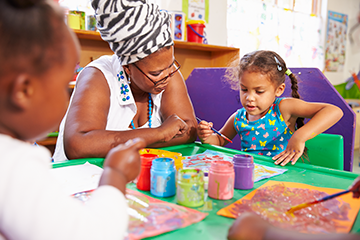What strategies can teachers use to support these children?
Page 5: Environment and Instructional Grouping
 By collaborating with families, teachers gain a better understanding of young ELs’ home language and developmental needs. With this information in mind, teachers can create supportive classroom environments and effective instructional groupings that will best meet the language and learning needs of all children and provide the foundation for implementing instructional strategies specifically designed to support young ELs with disabilities in their classroom.
By collaborating with families, teachers gain a better understanding of young ELs’ home language and developmental needs. With this information in mind, teachers can create supportive classroom environments and effective instructional groupings that will best meet the language and learning needs of all children and provide the foundation for implementing instructional strategies specifically designed to support young ELs with disabilities in their classroom.
Supportive Environment
Before implementing instructional strategies, teachers should create a supportive classroom environment to make all children feel comfortable and to facilitate communication development. The spoken and unspoken messages that children receive can positively or negatively impact how they view themselves and others. Therefore, teachers should strive to create environments that are welcoming, promote a sense of community, and are responsive to the needs of all children, including young EL children with disabilities. To learn more about creating environments for young children, see the IRIS Module:
DEC Recommended Practices
The DEC Recommended Practices on Environments refer to aspects of the space, materials (e.g., toys, books), equipment, routines, and activities that practitioners and families can intentionally alter to support each child’s learning across developmental domains. Although all the DEC Recommended Environmental Practices broadly apply to young ELs with disabilities, the two outlined below specifically refer to this population.
- E1. Practitioners provide services and supports in natural and inclusive environments during daily routines and activities to promote the child’s access to and participation in learning experiences.
- E3. Practitioners work with the family and other adults to modify and adapt the physical, social, and temporal environments to promote each child’s access to and participation in learning experiences.
- E6. Practitioners create environments that provide opportunities for movement and regular physical activity to maintain or improve fitness, wellness, and development across domains.
(DEC Recommended Practices, 2014)
Listen as Robert Stechuk discusses how teachers can help young ELs who understand little or no English adjust to the classroom environment (time: 1:54).

Robert Stechuk, PhD
Transcript: Robert Stechuk, PhD
For some DLLs, they’re going to come into classrooms with very little prior experience or no prior experience with English. So in that situation there’s basically a three-part strategy. Number one, we want to welcome the child into the classroom. We want to make it clear through words, gestures, smiles, body language, that we’re welcoming the child. We’re happy to have them in the classroom. Number two is we really want to introduce the child to the classroom. We want to offer choices to the child to get them involved in activities. So it may be a quiet, small, little manipulative while seated at the table. It may be using a climbing structure. It may be building with blocks. It may be looking with books. We want to figure out where are the child’s interests. We want to get them involved in activities that are engaging for the child. If the child is enthusiastic about painting then their attention is going to be focused on the painting. Once the child is engaged in the painting activity that is the time to bring the modeling of English to bear. So that teacher can talk out loud, those basic strategies of parallel talk and self talk: “Now you’re lifting your brush up and down. Now you’re dipping your brush in the paint. Now you’re making lines. Now you’re making circles.” Getting the child involved in an activity and then bringing models of English to correspond with the child’s actions, that is the basic approach that I would recommend for children who have little or no prior experience with English.
For Your Information
Many early childhood organizations provide resources designed to help early childhood educators establish high-quality inclusive environments. Links to a few of commonly used resources available through these organizations can be found below.
Early Childhood Technical Assistance Center (ECTA)
Technical Assistance and Training System &
Florida Inclusion Network
Technical Assistance and Training System
Instructional Grouping
 One component of creating a supportive environment, instructional grouping refers to how children are grouped within the daily routines of the classroom. It is important for teachers to consider the type of grouping that will best support the language and learning needs of the children, including young ELs with disabilities, throughout the day.
One component of creating a supportive environment, instructional grouping refers to how children are grouped within the daily routines of the classroom. It is important for teachers to consider the type of grouping that will best support the language and learning needs of the children, including young ELs with disabilities, throughout the day.
- Large-group instruction: Instruction either for the whole classroom or a large group of children (e.g., circle time). Teachers should be aware that young ELs, including those with disabilities, often have a hard time following instruction in a large group due in no small part to the challenges associated with their language differences and disabilities.
- Small-group instruction: Instruction for a small group of children selected according to their individual strengths and needs. Because teachers can more readily observe each young EL child in small-group activities, they can better support their learning and language needs.
- Individualized instruction: Instruction that is based on a child’s unique strengths and needs. With individualized instruction, teachers can target each young EL’s learning and language needs.
Listen as Rosa Milagros Santos discusses the importance of providing supports for young ELs to understand their environment and to access instruction (time: 2:14).

Rosa Milagros Santos, PhD
Professor, Special Education
University of Illinois at Urbana-Champaign
Transcript: Rosa Milagros Santos, PhD
Some of you might have had experience going into a different country where a different language is spoken, one that you may not be familiar with or one that you don’t speak. You look for certain things that may be familiar to you to help you clue in to what’s going on around your environment. If you’re in a different country, you have different words for “exit” and “entrance” or “bathroom” or “stop,” “go,” whatever it is. It’s really important for you to figure out what are these things. And there’s some universal-language ways to figure out some of these things. Like, for example, a picture of a woman for a bathroom, or a picture of a man for a men’s bathroom.
Same thing with kids. They go into an environment that’s new to them, that may have a lot of words, a lot of pictures that may not be familiar to them. Our role as a teacher is to make sure that that environment is something that the child can connect back to something that they know so that they can access it in a way that’s meaningful for them. It’s hard on a young child to go into a room and to a new environment and not understand how the teacher talks to them or how their friends are talking to them because they don’t understand the language. Provide supports for that child to understand their environment, so they can see a picture of food, “Oh, right here. This is where I can get my water.” “Oh, this is where I have my picture, so this must be where I put my things, or where I hang my coat.” Things like that help them find a way to connect to their environment.
In terms of instructional groupings, it’s important for some children to learn new content along with their peers that speak the same language, by someone who preferably can deliver that instruction in the children’s language, as a way to help them begin to access that information initially. Then when the teacher introduces that same concept to a larger group, they have a link to remember we talked about, what fall is, and why leaves fall off the trees, and the colors of the leaves, and all these things in their small groupings. When the teacher introduces it in English then they have a context of what the teacher is talking about. Those things are very intentional, especially for young children who are not as fluent yet in the school language.
To learn more about environmental supports listen to IRIS interview:
A look inside Mrs. Raymond's classroom
Mrs. Raymond learns from Ms. Mansilla that young ELs, especially those with disabilities, often have a difficult time following instruction and learning in large-group activities. Because of this, Mrs. Raymond dramatically reduces time spent in large-group activities. For those instances when she does consider such activities (e.g., circle time), she asks questions that promote group discussion instead of asking questions that encourage the response of a single child. During small-group activities like reading, she observes and documents what each child knows and what language supports he or she needs. Furthermore, she is intentional in selecting books that represent her students’ backgrounds. These observations in hand, she asks some children to point at objects in the book, and with others she reviews target vocabulary. During individualized instruction, she determines when to ask open-ended questions that allow children the opportunity to use short phrases to practice their language skills. When appropriate, she also pairs visual cues with auditory cues throughout the day, particularly during transitions.
Instructional Strategies
Within the context of supportive environments and effective instructional grouping, teachers can use a variety of evidence-based strategies to support the needs of young ELs with disabilities. Teachers can easily implement the following instructional strategies, each of which will be described in more detail on the following pages:
evidence-based strategies
Techniques and practices that have been shown to be effective through multiple high-quality experimental research studies or large-scale research field studies; the criteria for identification of these strategies varies by organization or agency.
- Use visual supports
- Use familiar and non-stereotypical materials
- Learn and utilize some of the child’s home language
- Promote peer support and interaction
DEC Recommended Practices
The DEC Recommended Practices on Instruction refers to the practices that maximize learning and improve developmental and functional outcomes for young children who have or are at risk for developmental delays or disabilities. These instructional practices are intentional and systematic strategies to inform what to teach, when to teach, how to evaluate the effects of teaching, and how to support and evaluate the quality of instructional practices implemented by others. Although all the practices broadly apply to young ELs with disabilities, those below most closely align to this population.
- INS8. Practitioners use peer-mediated intervention to teach skills and to promote child engagement and learning.
- INS11. Practitioners provide instructional support for young children with disabilities who are dual language learners to assist them in learning English and in continuing to develop skills through the use of their home language.
- INS12. Practitioners use and adapt specific instructional strategies that are effective for dual language learners when teaching English to children with disabilities.
(DEC Recommended Practices, 2014)


